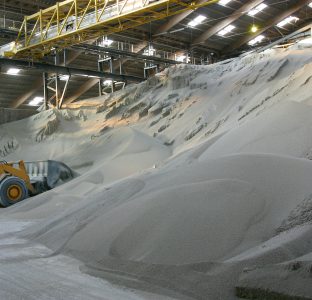How to Improve Fertilizer Shelf-Life
Storage best practices can prolong fertilizer’s effectiveness and potency
Depending on the type, fertilizer can last for years in storage. Liquid fertilizers can last upwards of 10 years, and granular fertilizer has no finite expiration date. It isn’t just the chemical makeup of these products that affects their longevity – proper storage is key.
Effects of improper storage
Without proper storage, the most immediate impact is a complete loss of product. This loss of product happens in a few specific ways:
- Caking/Clumping – When stored fertilizers are exposed to humidity, the granules clump together, creating a caking effect and greatly reducing a fertilizer’s flowability. Not only can this occur in warm temperatures, but it is also possible during colder seasons, due to the condensation that forms inside improperly sealed storage areas.
- Leaking and spills – Fertilizer shelf-life is further impacted by leaks and spills, which happen when fertilizer is not stored in the right conditions. Product can be lost to soil and water sources, which can also create danger for product contamination.
- Explosions and fires – Fertilizers that are placed near incompatible chemicals or flammable materials can cause combustion explosions and fires. This can result in loss of life, equipment, and facilities, in addition to product.
Despite these challenges, by using a handful of best practices, one can easily prolong fertilizer shelf-life and preserve its chemical strength and effectiveness.

Granular fertilizer is best preserved when stored indoors.
Best practices to extend fertilizer shelf-life
Though there are several different ways to store and protect fertilizer, there are three key steps every facility can take to get the best results.
Store fertilizer indoors
While there are currently some industrial solutions for outdoor fertilizer storage, including liquid fertilizer tanks and permanent storage tanks, both varieties are subject to extensive regulations and approval from government environmental agencies. Therefore, indoor storage is the most economical and effective option.
Indoor storage also protects fertilizer product from exposure to UV rays and reduces the risk of freezing. With UV exposure, some fertilizer granules can heat, which decomposes the nitrates contained within. Decomposed nitrates produce nitrogen, carbon, and sulfur oxides, all of which weaken the product, and can cause fires and explosions if they’re stored near flammable materials. Also, when frozen, chemical elements of the fertilizer can separate, further diluting its power. There is a high probability that the fertilizer will not work as intended once it has thawed and then been reformed.
Indoor storage is therefore a far more effective way to extend fertilizer shelf-life. However, it is important to ensure that the indoor conditions are ideal. Among many aspects, facility managers must observe the following guidelines:
- Store fertilizer in an area that is not made of combustible material.
- Also, store fertilizer away from incompatible materials or chemicals. For example, if your facility manufactures urea and ammonium nitrate-based fertilizers, they must be separated to avoid a potentially lethal reaction.
- The fertilizer storage area must have proper ventilation.
- All fertilizer should be stored on a surface that’s dry, level, and free of any holes.
- Fertilizer should be stacked in such a way that it won’t collapse, i.e. limit height.
- Fertilizer should be stored away from the facility’s eaves and beams.
Store fertilizer in a low-humidity environment
Fertilizer is hygroscopic, which means it absorbs moisture from the air around it. If the air surrounding the stored fertilizer is humid, then water will be absorbed, thereby diluting and caking your product. Simply keeping your fertilizer protected from outdoor conditions and precipitation is not enough. Humidity poses one of the biggest threats to fertilizer shelf-life. This threat looms during production, storage, transit, and bagging.
In addition to caking, humidity can zap fertilizer of its free-flowing properties as well as its physical, nutrient, and chemical properties. It can even cause crystallization. Not to mention, caked fertilizer can create numerous health hazards. For example, large clumps can break off piles and fall on workers, harming them. Or they can form in farmers’ storage bins, putting them in danger as they try to loosen clumps to move the fertilizer out of the bins.
To address this, air in the fertilizer storage space must be properly conditioned to stop the excess production of moisture. The temperature must be regulated, hovering right around 81 degrees Fahrenheit and a relative humidity level between 30-40%. Two solutions that achieve this regulated temperature are mechanical refrigeration and industrial-grade dehumidification. The right solution(s) depends on the facility and its budget.
Use a protective coating
Lastly, one powerful way to protect fertilizer shelf-life is a protective coating. Protective coatings can minimize caking and moisture pickup, control fertilizer dust, and even enhance flowability. There are several types, including coating oils, particulates, polymer systems, and water-soluble liquids.
One such protective coating is MinTech’s Cake Brake, an anti-caking solution formulated to provide long-lasting anti-caking protection. Cake Brake alters the interfacial surface tension between the treated granules, which stops crystallization and adhesion to surfaces. It also prevents pile-set and bag-set during storage and transportation.
Additional best practices
In addition to the steps outlined above, it is also a great idea to use a pallet system, which helps avoid excessive stacking. Also, put a good stock management system in place to ensure none of the fertilizer products stay stored for prolonged periods, and ensure the storage environment remains as hygienic as possible.
Fertilizer product is susceptible to a lot of environmental dangers both in the facility and as it goes through the latter stages of the manufacturing process. These vulnerabilities can be controlled with the right processes in place. Extend your fertilizer shelf-life with a few strategic moves.
Visit mintech.com/minterra to find out more about MinTech’s fertilizer dust control and anti-caking products.
